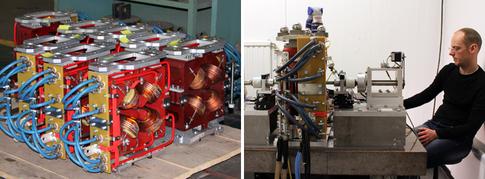XFEL: In-kind contributions: 125 magnets delivered from Russia and Sweden
In-kind contributions: 125 magnets delivered from Russia and Sweden
On 17 July, 125 magnets custom-built for the European XFEL arrived in Hamburg. The quadrupole magnets will be used to focus the electron beam between the undulator segments—the magnetic structures in which the electron beam generates the X-rays.
Based on a design by Deutsches Elektronen-Synchrotron (DESY), the 125 magnets were produced by Budker Institute of Nuclear Physics (BINP) in Novosibirsk as a Russian in-kind contribution (IKC) to the European XFEL facility. After production, they were shipped to Manne Siegbahn Laboratory (MSL) at Stockholm University, where they were measured and “fiducialized” as part of a Swedish IKC to the facility. “Fiducialized” means that their magnetic centreline position was measured and indicated by “fiducials” on the magnet’s surface to allow its correct positioning with respect to the direction of the electron beam. The next step will be the final assembly and alignment in the undulator intersections of the European XFEL.
“Congratulations to our Russian and Swedish partners, and to project leaders Ivan Morozov at BINP and Anders Hedqvist and Fredrik Hellberg at MSL, for the successful completion of these important in-kind contributions”, said Serge Prat, IKC coordinator at European XFEL. “We are very pleased to have reached this significant milestone in the construction of the European XFEL.”
European XFEL shareholders contribute to construction costs in cash or in kind. IKCs can take the form of component delivery, secondment of staff, or both. To date, European XFEL has received proposals for 76 IKCs from 10 different countries for a total of 563 million euro.

